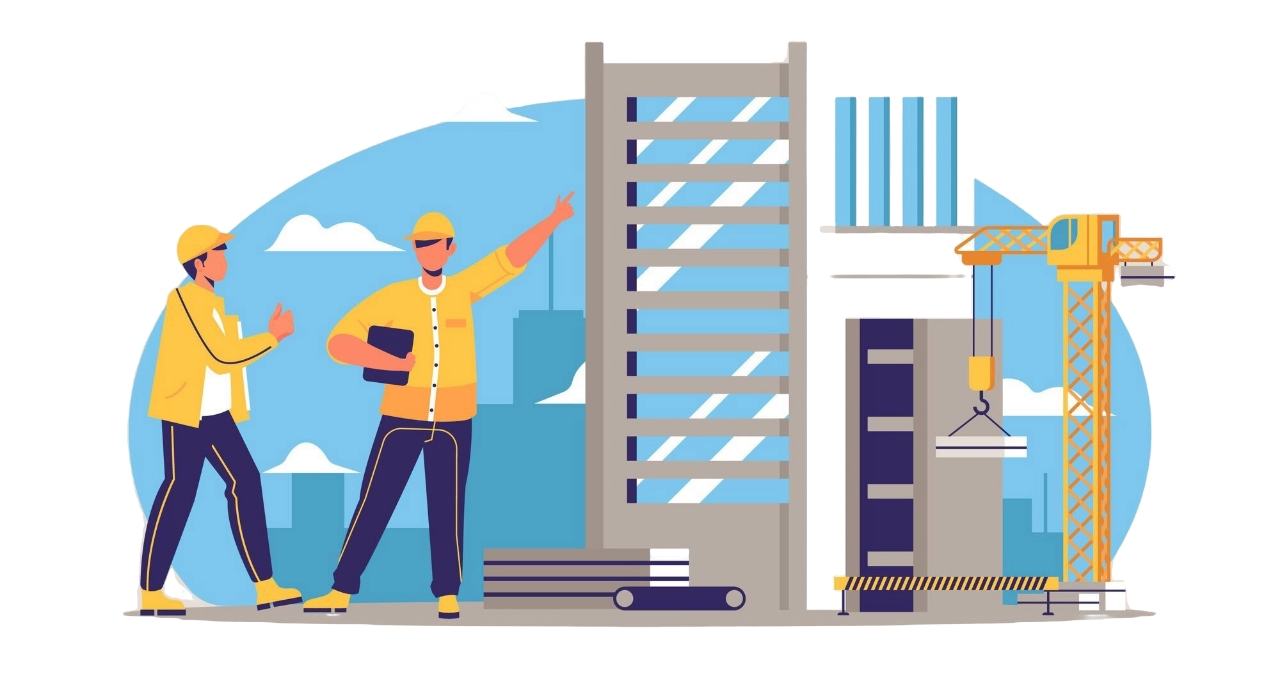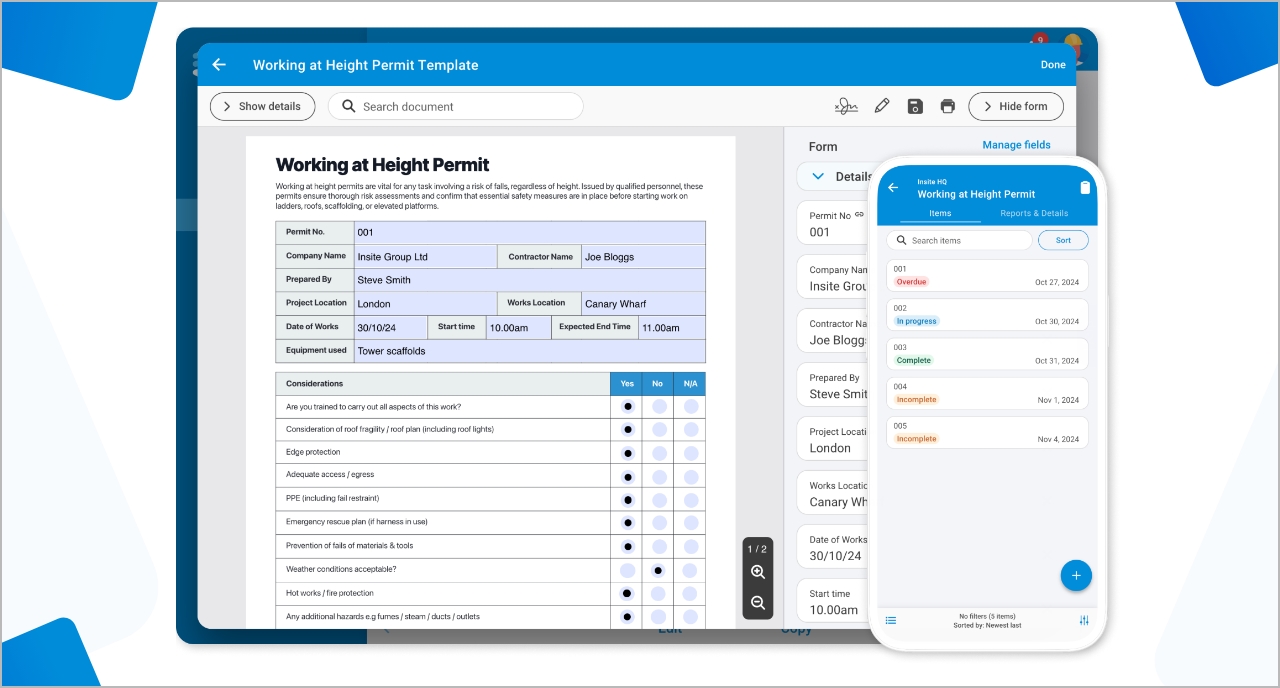Resources
Case studies
Videos
Sample reports
Free inspection templates
Learn
Blog
Product brochure
Training pack
Get the app
Download the app
Changelog
2024-10-30 | 6 min read
tags: Safety Free-Template Process Insite
Building safer construction sites with the right Working at Height Permit Template

In the fast-paced and hazardous environment of construction, ensuring safety protocols for tasks like working at height is critical. Falls from height remain one of the leading causes of serious injuries and fatalities on construction sites. A well-designed Working at Height Permit helps manage and mitigate these risks by establishing formalised procedures and controls. This blog dives into the essentials of working at height permits and offers guidance on how the right template can enhance safety across construction projects.

Understanding Working at Height Permits
What Are Working at Height Permits?
A Working at Height Permit is an official document that authorises work involving elevated tasks, ensuring that essential safety checks are completed and approved before work begins. These permits aren’t mere paperwork; they’re integral to a comprehensive safety protocol that reduces risks and safeguards workers’ well-being.
Types of Working at Height Tasks in Construction
Working at height encompasses various tasks with specific safety needs, such as:
- Roofing: Repairing, replacing, or constructing roofing materials.
- Scaffolding: Installing or dismantling scaffolding structures.
- Ladder Work: Tasks involving prolonged use of ladders or access platforms.
- Use of Lifts: Operating aerial lifts or cranes for elevated work.
Each of these tasks comes with unique hazards, making it crucial to customise the permit to cover specific safety requirements.

The Need for a Working at Height Permit
Potential Hazards of Working at Height
The primary risks associated with working at height include falls, equipment failure, and environmental factors like strong winds or poor visibility. These hazards are heightened in construction due to unstable surfaces, the presence of tools and materials, and potential environmental shifts that make conditions unsafe.
Legal Requirements and Compliance
Working at height is regulated by the UK Work at Height Regulations 2005, which mandates safety measures for employers to protect workers performing tasks above ground level. Compliance with these regulations is a legal requirement that not only mitigates risks but also helps avoid penalties. Proper use of permits supports both compliance and best practices on-site, prioritising safety above all.
Case Studies Highlighting Incidents Due to Lack of Permits
A notable example underscoring the importance of height safety is the 2019 incident on a UK construction site where a worker sustained severe injuries after falling from an inadequately secured scaffolding platform. Investigations revealed the absence of a working at height permit, highlighting both the safety and legal repercussions of bypassing such protocols.

Components of a Working at Height Permit Template
A detailed Working at Height Permit template serves as a roadmap for safe elevated tasks. Here are the key components that should be included:
Project Details
- Project Name/Location: Identifies where the work at height will be conducted.
- Date/Time: Specifies when the work is authorised, ensuring it occurs within approved parameters.
Description of Work at Height
- Type of Work: A clear outline of the specific task (e.g., scaffolding, ladder work).
- Equipment Used: Lists all equipment and tools involved, allowing for targeted risk assessments.
Safety Measures
- Fall Prevention: Documents all fall prevention measures, including guardrails, nets, and harnesses.
- Personal Protective Equipment (PPE): Specifies PPE requirements for workers involved in the task.
Authorisation
- Permit Issuer: Identifies the individual authorising the work, typically a safety manager or project supervisor.
- Worker Acknowledgement: Signature from workers confirming their understanding of and compliance with safety protocols.
How to Use a Working at Height Permit Template
Using a Working at Height Permit template effectively requires careful attention to detail. Here’s a step-by-step guide:
Filling Out the Template
- Conduct a Risk Assessment: Identify and evaluate potential hazards specific to the task and location.
- Complete Each Section: Accurately document details to ensure comprehensive oversight of the task.
- Review Safety Measures: Confirm that all listed measures are in place and ready for use.
Best Practices
- Maintain Records: Keep a log of all issued permits to support compliance and streamline audits.
- Ongoing Training: Regularly train all site personnel on height-related hazards, ensuring they understand the permit process and safety protocols.

Integrating Working at Height Permits into Your Project
Incorporating working at height permits into your project plan isn’t only about completing a form; it’s about creating a safety-conscious culture.
Integration into Project Planning
- Pre-Planning: Include the permit process in your initial project stages, allowing time for risk assessments and necessary equipment preparations.
- Clear Communication: Regularly update all on-site personnel about the importance of working at height permits, extending awareness beyond the immediate team to include everyone on-site.
Training and Communication
- Safety Training: Conduct sessions focusing on height-specific hazards, the correct use of PPE, and permit protocols.
- Feedback Mechanism: Encourage workers to share insights about safety processes, enabling continuous improvements in protocols.
Regular Audits and Updates
- Audit the Process: Regularly review your working at height permit process, verifying adherence and identifying areas for improvement.
- Adapt and Update: Stay adaptable to new regulations and feedback from team members, adjusting your template and protocols as needed.
Digital vs. Paper Working at Height Permits
The Digital Advantage with Insite
- Accessibility: Digital permits, like those managed through Insite, are accessible from any device, allowing real-time updates and streamlined coordination.
- Instant Updates: Insite’s system supports rapid communication of changes, ensuring everyone has the latest information.
- Enhanced Record-Keeping: Digital systems simplify permit management, making compliance tracking, audits, and retrieval faster and more efficient.
Considerations for Paper Permits
- Simplicity: Paper permits provide a straightforward, no-tech solution, ideal in areas with limited digital access.
- Immediate On-Site Presence: Physical permits can be posted visibly at the work location, serving as a reminder of safety protocols.
Whether digital or paper, the choice depends on project needs. Many sites are moving towards digital solutions for added convenience and safety compliance.

Choosing the Right Working at Height Permit Template
When selecting a Working at Height Permit template, consider customisation, scalability, and ease of use to ensure it meets the unique needs of your site.
Customisation Is Essential
Choose a template that can be tailored to accommodate specific risks and requirements of each task, ensuring all relevant hazards are covered.
Scalability and Flexibility
As projects grow in size and complexity, the template should remain adaptable, accommodating various types of height-related work.
User-Friendliness
Opt for a template that is easy to use and understand, minimising errors in completion and promoting consistent safety compliance.
Legal and Insurance Considerations
Understanding Legal Requirements
The UK Work at Height Regulations 2005 mandate specific protocols for working at height. Compliance with these standards is a legal requirement, helping prevent accidents and potential penalties.
Impact on Insurance
Using a working at height permit is often a condition of insurance policies covering construction work. Proper permit processes not only improve site safety but also help ensure that insurance coverage remains valid in case of incidents.
Conclusion
Implementing a well-designed Working at Height Permit template is fundamental for boosting safety on construction sites. A permit that is adaptable, scalable, and easy to use ensures consistent compliance with safety standards and fosters a safety-first culture. Whether digital or paper, integrating a working at height permit into your project planning significantly reduces the risks associated with height tasks, leading to a safer, more efficient construction environment.
To elevate your site’s safety protocols, download our free Working at Height Permit template. This user-friendly template is crafted to meet the needs of construction projects, supporting you in creating a safer work environment. Make it an essential part of your safety toolkit, and feel free to share your experiences and results with us. Together, we’re building safer construction sites.
Download our free Working at Height Permit Template
Looking to improve your site safety and compliance? Download our free Working at Height Permit Template to ensure every worker is fully informed before starting work. Don’t wait - start safeguarding your construction site now!